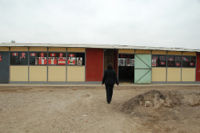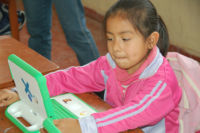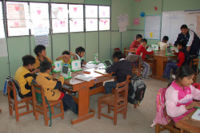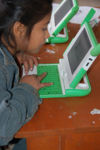OLPC Peru/Chincha: Difference between revisions
No edit summary |
m (Chincha moved to OLPC Peru/Chincha) |
||
| (5 intermediate revisions by 3 users not shown) | |||
| Line 1: | Line 1: | ||
<noinclude>{{ GoogleTrans-en | es =show | bg =show | zh-CN =show | zh-TW =show | hr =show | cs =show | da =show | nl =show | fi =show | fr =show | de =show | el =show | hi =show | it =show | ja =show | ko =show | no =show | pl =show | pt =show | ro =show | ru =show | sv =show }}</noinclude> |
|||
=== Location of Chincha === |
=== Location of Chincha === |
||
Chincha is a town about 200km south of Lima, Peru. 4 out of 155 of their schools were chosen to receive XO laptops due to their poverty and student population. This town was hit hard by an earthquake 1 year ago. |
Chincha is a town about 200km south of Lima, Peru. 4 out of 155 of their schools were chosen to receive XO laptops due to their poverty and student population. This town was hit hard by an earthquake 1 year ago. |
||
| Line 16: | Line 17: | ||
More pictures can be found here: |
More pictures can be found here: |
||
[http://flickr.com/photos/kentquirk/sets/72157606353435234/ |
[http://flickr.com/photos/kentquirk/sets/72157606353435234/ Chincha Pictures] |
||
<BR> |
<BR> |
||
| Line 66: | Line 67: | ||
Director of Chincha UGEL: |
Director of Chincha UGEL: |
||
* Dr. Jose Rivas |
* Dr. Jose Rivas Castro |
||
Teachers at Chavalina school in Chincha: |
Teachers at Chavalina school in Chincha: |
||
| Line 72: | Line 73: | ||
* Jana Luisa, teacher |
* Jana Luisa, teacher |
||
* Maria Graciela, teacher |
* Maria Graciela, teacher |
||
[[Category:Field Reports]] |
|||
[[Category:OLPC Peru]] |
|||
Latest revision as of 19:01, 15 August 2008
Translate this page with Google -español -български -中文(中国大陆) -中文(臺灣) -hrvatski -čeština -dansk -Nederlands -suomi -français -Deutsch -Ελληνικά -हिन्दी -italiano -日本語 -한국어 -norsk -polski -português -română -русский -svenska
Location of Chincha
Chincha is a town about 200km south of Lima, Peru. 4 out of 155 of their schools were chosen to receive XO laptops due to their poverty and student population. This town was hit hard by an earthquake 1 year ago.
Our visit was on July 23, 2008.
- Town Population: 50,000
- Total number of Schools: 155
- 4 schools receiving XO Laptops:
- Chavalina, 71 students
- Yanac, 15 students
- Liscay, 35 students
- San Pedro, 72 students
We visited the Chavalina school, which is 3 classrooms with two grades each, a total of 71 students. There are three teachers. We had a chance to observe a class, speak to the students, watch a demonstration of local dance, speak with the teachers and speak with the director of all the Chincha schools, Dr. Jose Rivas Castro.
More pictures can be found here: Chincha Pictures
Environment
Chincha was hit pretty hard by an earthquake about a year ago and is rebuilding many homes. Two of the three classrooms in the Chavaline school are temporary construction.
One classroom has working mains outlet for recharging as many as 4 or 5 laptops at one time. They rarely have all 70 laptops charged and working at the same time. There is very little direct sun for 4-6 months out of the year, so this is not a good candidate for solar.
There is no internet connectivity or school server. They don't need a school server right now as they have not seen any problems with the way they are using the laptops (not a lot of collaboration). They are very happy with the laptops.
Benefits
Everyone we met at Chincha were excited and happy with the laptops in the classroom. They got the laptops in late April and all the students and teachers continue to use them on a daily basis. The kids bring the laptops home, but most of them do not have power at home.
The teachers told us that the students learn very quickly. The laptops keep kids coming to school every day. 10 more students enrolled in the Chincha schools with laptops since the start of the program.
They are using the laptops for combined activities such as writing out their vocabulary words and making a memorize game out of the words and synonyms. They use paint or record to get a picture and make a puzzle out of it.
In terms of collaboration, they have used chat, shared photos, and shared write documents. They reported no problems with the activities they are using or with the collaboration. I believe their curriculum doesn't rely heavily on sharing (only one or two laptops at a time) and their scarcity of power means many of the laptops are waiting to be charged at any given time.
Difficulties
They have already seen:
- One broken screen
- One bad battery
- Two keyboards with ripped keys
- One with no sound
- Jumpy cursor, touchpad problems (quite a few, but they do go away over time so they are able to continue using these laptops)
When laptops need to be charged, they have to stop using them for a few hours that day. One teacher felt certain that a full charge takes 4 hours rather than the 1.5 to 2 hours that is stated in the manual. While a laptop is charging, the child goes without a laptop while the lessons continue.
They are just learning about the process for reporting problems to the Ministry and requesting spare parts and repairs. This is still pretty new for them, but their teacher's manual has the email address and phone number to call when they have problems with the laptops.
Their teacher manual also have detailed instructions on how to replace a display screen, so we replaced their broken one with one that we brought with us to go through this.
People
Traveling from Lima to Chincha:
- Manuel Quevedo Zamora - Ministry of Education, Master teacher
- Marcela Wong Vilchez - Translator and student of education
- Kent Quirk - OLPC volunteer and photographer
- Kim Quirk - OLPC, VP Software and Support
Director of Chincha UGEL:
- Dr. Jose Rivas Castro
Teachers at Chavalina school in Chincha:
- Maria Ester, teacher/director
- Jana Luisa, teacher
- Maria Graciela, teacher



